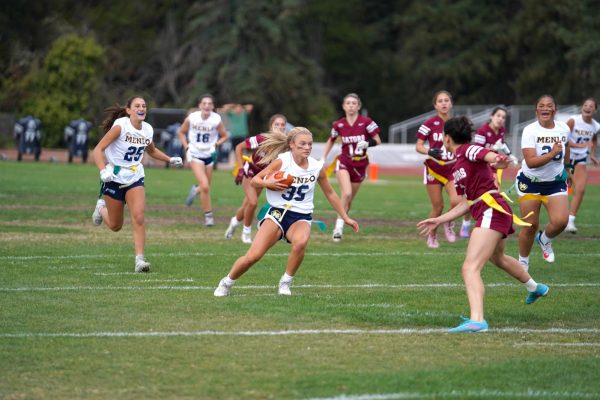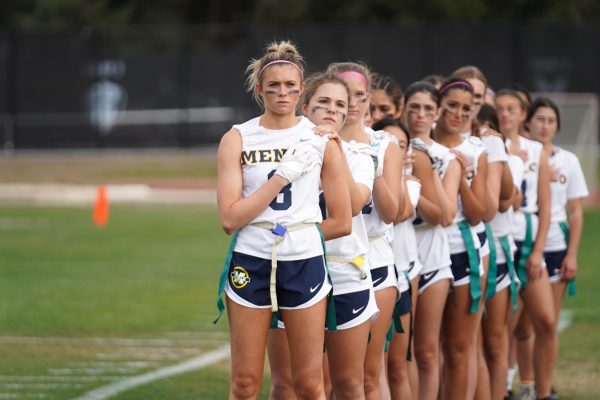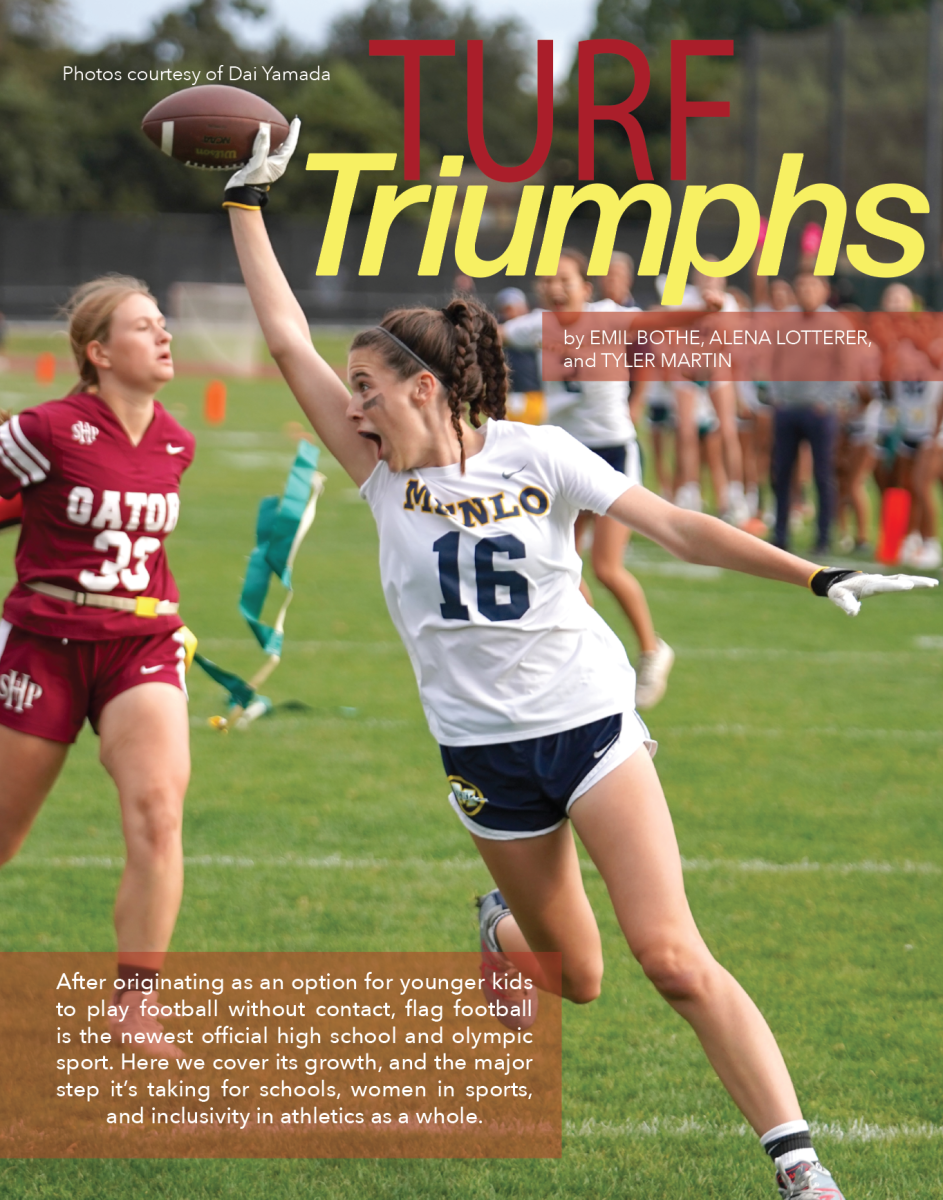Cheering in unison and decked out in festive outfits, students, faculty, family, and friends pack into the stands of high school stadiums for Friday night lights. In high school athletics, football is the sport that takes the spotlight, as it typically has the largest fan base and receives the most attention. Though almost every high school sport has both a girls and boys team, the biggest high school sport does not. Girls across the nation have shown great interest and enthusiasm towards football and the possibility of playing it, yet there is no opportunity for them to participate and represent their school in the exciting sport. However, this year that is changing via the introduction of flag football to high school athletics.
Originally, flag football was used as a safer alternative for younger kids – both male and female – to play football without the risks of injuries that’s predisposed in contact sports. Recently, with the massive growth in flag football’s popularity, the idea of offering flag football to female high school athletes as an alternative to tackle football has gained momentum. With growing popularity and support towards flag football, more serious debates began on whether to add it as a girls high school sport. On February 3, 2023, the California Interscholastic Federation (CIF) approved the proposal for flag football to be officially added to high school athletics by a unanimous 146-0 vote, officially setting flag football as a fall sport to start in the 2023-2024 school year.
In the 2023 fall season, girls flag football made its debut on high school fields. With girls throughout Bay Area high schools jumping at the opportunity to finally play football, the majority of private schools in the area and some public schools have put together and established flag football teams over this past summer and fall. At Menlo School, senior Paige Miller, who had been immersed in the sport of football in prior years by having a brother who plays football, expressed immediate interest in having a team formed and playing at this new competitive level along with a shared enthusiastic and excited reaction to the new sport that ran throughout their student body.
“My older brother talked about how he loved the community of football and so being able to have that experience on my own was really special and I knew I wanted to try it,” Miller said. “So many people showed up to the interest meeting that I think it kind of surprised the athletic administration, and instantly there was a lot of excitement around it, especially having it in the fall season because it attracts girls from so many sports. We had girls from soccer, basketball, lacrosse.”

Here at Paly, the student population has also expressed flooding interest in the new high school sport. Paly’s Athletic Director, Jennifer Crane, explains the reflection of Paly students’ interest in flag football in a survey sent out to Paly’s students.
“We sent out an interest survey to the student body to see how many students would be interested in participating in girls flag football to see if it was something that we should start working toward,” Crane said. “Based on the responses that we got, it looks like there’s enough people who are athletes that are interested where it would make sense to start the efforts.”
Despite high interest from students, Paly is one of the schools that did not make a team. With just seven months between the vote to initiate flag football in CIF and the start of the new school year, the Paly athletics department encountered several barriers in the discussion and logistics of forming a team.
“As you can imagine, the turnaround time from April to August was very short because there’s a lot of different steps that needed to be taken,” Crane said.
The formation of a sport is a lengthy process that includes many steps and components. With that being said, public schools face particular difficulty in forming new sports teams given the district approvals, resource discrepancies, and budgeting that private schools – which are independent of school districts – don’t have to consider as much.
“We have to propose to the board that we get stipends on the salary for coaches to actually coach girls flag football because the district actually funds the coaching salary,” Crane said. “We can’t hire coaches if we have no way to pay for them.”
Additional difficulties in adding girls flag football to Paly athletics stemmed from coordination within SCVAL (Santa Clara Valley Athletic League) in fielding multiple new teams. Schools had to consider the availability of field space for another fall sport and having other teams in the league to play.
“You can imagine if you have girls flag football, football and field hockey, there’s going to be an issue with field space,” Crane said. “So trying to figure out the logistics within that, and then who in the league had the bandwidth to actually field girls flag football team this fall,” Crane said. “Having the consideration of adding a new girls sports team makes you wonder how that’s going to impact the turnout for the other sports that already exist.”
Mostly schools without field hockey teams were able to form girls flag football teams. Only two out of fourteen schools in SCVAL ended up being able to debut a team, and they both do not have field hockey as a sport. Hence, not having many schools in SCVAL pushing for a team to be fully organized this past fall discouraged other schools in the league from pushing to organize a team, for they wouldn’t have had other schools to play against.
Paly’s athletic department has instead made the decision to circle back and aim to debut a team in the 2024 fall sports season. In the meantime, they’re working with Paly’s Student Athletic Leadership Team to run intramural flag football during lunch in the winter and spring.
While Paly and other public schools in the area were unable to form a team on short notice, many private schools have already implemented teams and started playing games this past fall.
Former San Francisco 49ers quarterback, NFL Hall of Famer, and current Menlo Flag Football coach, Steve Young, expresses how he first decided to become a flag football coach.
“Well, I was invited . . . [my daughters] said, ‘Dad, you should help coach.’” Coach Young said. “I went over there, not knowing exactly how it would go, but it ended up being one of the joys of my life. It was a fun, fun time.”
Coach Young expresses how well his players have adjusted and how flag football creates an inclusive environment for coaches and players.
“The girls feel that sense of inclusion, that sense of ‘I’ve been watching this game forever’ and now I get to play it,” Coach Young said. “There was real joy about that.”
Just like any other sport, participating in flag football takes dedication and effort everyday after school. Coach Young explains the typical week and practice schedule.
“Every day from 3:30-5:00 and games are usually Wednesdays,” Coach Young said. “Practice is really just getting warmed up, gear up, and go like we used to do in the old days. Then, we just really scrimmage offense versus defense, just running plays so they get a sense of the choreography.”

Coach Young further noted how the high school girls picked up plays much quicker than previous boys that he had coached. “That’s the thing about girls [is] that they took it so quickly.” Coach Young said. “The boys have always struggled, even the guys I played professionally with, to get everybody on the same page and get everybody focused.”
Paige Miller added her thoughts about their team chemistry and picking things up quickly.
“I think we have team chemistry because we were showing enthusiasm about this new sport and had a competitive nature,” Miller said.
In football, both flag and tackle, it is essential that every player on the field understands the play, the timing of it, and communicates with each other for full effect. Coach Young emphasizes how nailing down these different aspects relate to the nature of other sports the girls have participated in.
“Once the girls understood that really, football is glorified choreography, it’s a dance step,” Young said. “Everybody needs to play a role and everyone does their individual patterns.”
Menlo’s quarterback, Ava Allen (‘27), emphasized how over time, the team’s ability to work together and understanding the game grew, despite being inexperienced originally.
“At the beginning of the season, we had a lot of people who had never even touched a football so we had no idea what the plan [was],” Allen said. “But towards the end of the season that rarely happened and we really put [everything] together.”
Menlo’s wide receiver and cornerback, Summer Young (‘24), shared another interesting aspect of the team is that everyone is relatively new to the sport. Unlike most high school sports, where athletes had been playing the sport for years prior, most football players have little to no experience playing competitive flag football.
“We were able to gather people from so many different sports. From basketball, soccer and lacrosse [who] never usually get to compete with each other which is one reason why it was so special,” Young said. “And I think that’s also a reason why we performed so well, we had people from [different] backgrounds or sports.”
Menlo did in fact perform well, going 15-1 and beating Sacred Heart (the only team they had lost to) 40-0 in the final game.
Most importantly, the addition of girls flag football to CIF has opened the door to new and unique experiences and opportunities for girls.
“I’ve never looked forward to a practice more in my life than when it came to flag football. Every single day I would look forward to practicing because it was just so fun,” Young said.
Paige Miller adds to how eye opening of an experience flag football’s debut in high school athletics was.
“I kind of forget what it was like not having flag football because I’ve made so many new connections and friendships,” Miller said. “So before it existed, I didn’t know what I was missing.”
Similarly, wide receiver and safety Ellie Knoll (‘25) looks back on her fondest memory and the impact it had on her.
“As a female athlete, I’ve never seen a big crowd or fan base in any of my sports. In our last game against Sacred Heart Prep, we had so many people from students to reporters in the stands, and it was so unique and I was so excited to see a whole crowd behind us,” Knoll said.
Men’s and women’s flag football will also be introduced as an Olympic sport in the summer of 2028. With the addition of flag football as an olympic sport, it will give people the opportunity to watch female athletes compete at the highest level and could potentially change the way people view the game.

“I think [The Olympics are] what’s going to make the difference,” Coach Young said. “Perceptions [about the sport] are going to change because they’re going to watch it.”
Overall, the growth of flag football and the addition of it as a high school sport will have a major impact on the landscape of female athletics. Aside from attention to the sport, legitimizing flag football as a competitive high school and olympic sport will allow millions of girls previously unable to play football due to gender restrictions to now have an opportunity to compete and fulfill their dreams of playing football.






